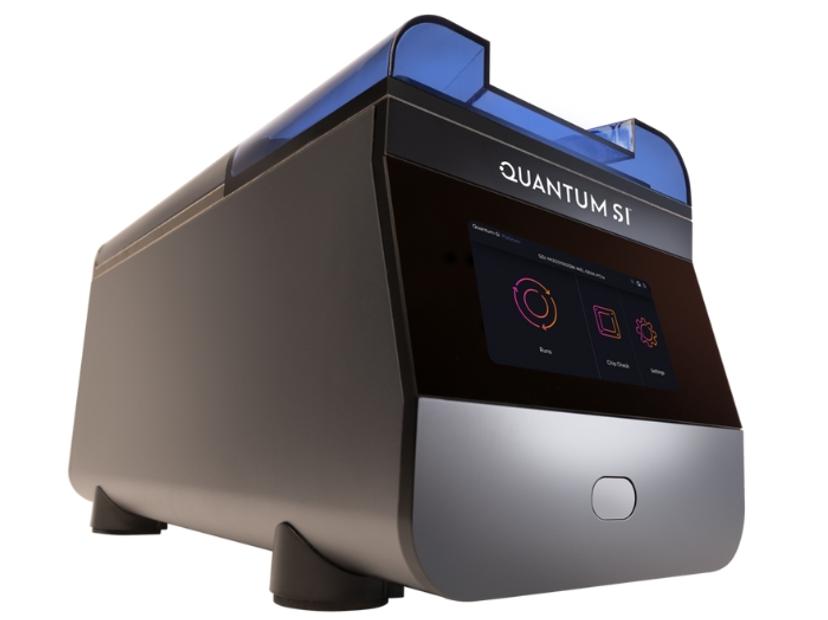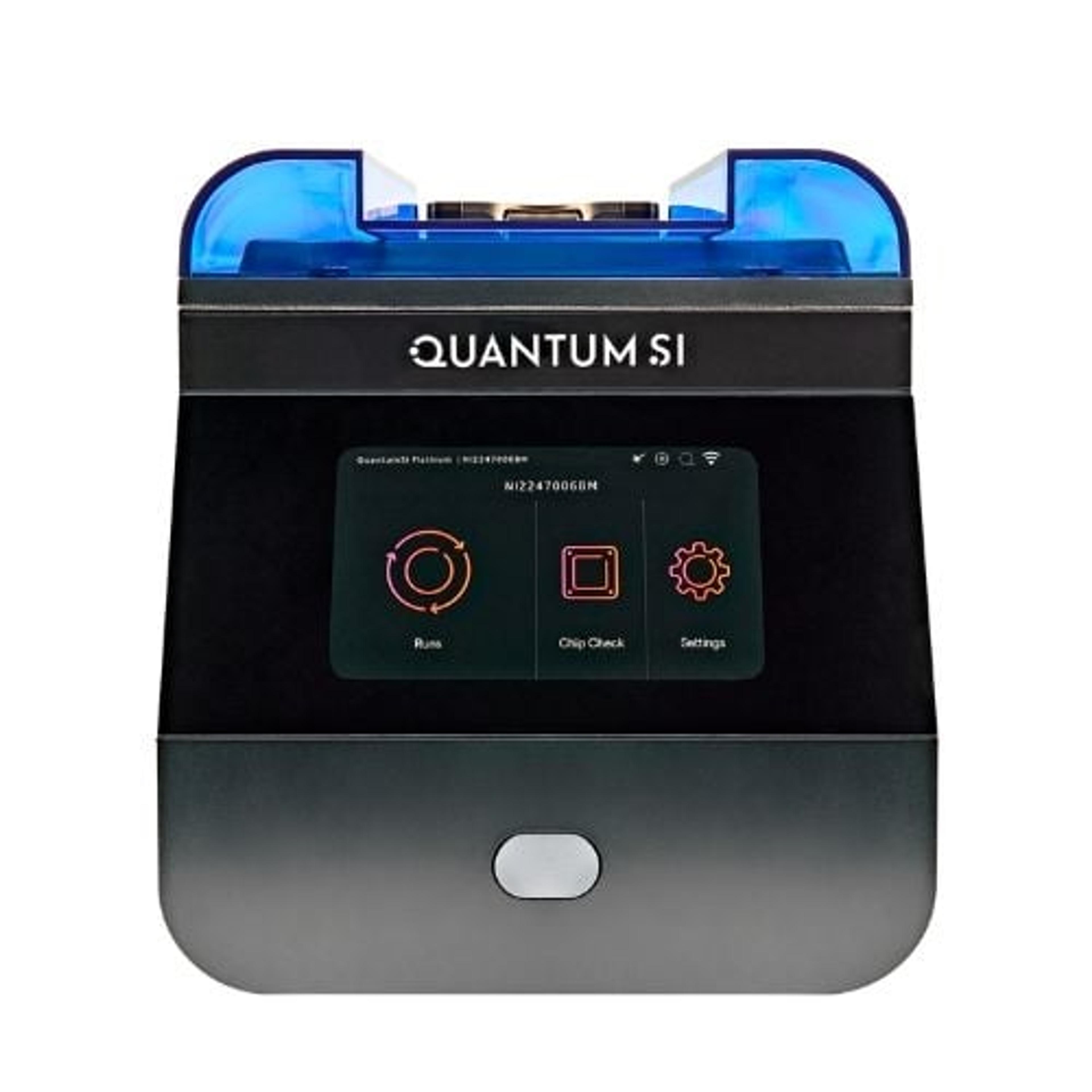Next-generation single-molecule, protein sequencing platform set to transform proteomics
Platinum®, Quantum-Si’s innovative protein sequencing platform, could bring affordable, benchtop protein sequencing with automated analysis to every lab
6 Aug 2023
Jeff Hawkins, CEO of Quantum-Si, discusses the capabilities of the Platinum protein sequencing platform, how it overcomes the limitations of traditional proteomics methods, and what impact it will have on the future of proteomics research.
The field of proteomics has long awaited a transformation similar to genomics, where the advent of scalable, single-molecule DNA sequencing has propelled our understanding of diseases and paved the way for personalized medicine.
The complex nature of the proteome and the chemical properties of proteins, however, have posed persistent challenges to achieving a level of sensitivity, throughput, and widespread adoption comparable to DNA sequencing technologies. The high costs associated with current mass spectrometry-based approaches, coupled with the need for bioinformatics expertise, have further limited the accessibility of proteomics, with most academic departments relying on large core facilities to characterize their samples.
Quantum-Si is changing this narrative with Platinum, its next-generation single-molecule protein sequencing benchtop platform.
Beyond the genome
“Proteomics has been the field that researchers have been trying to get to for years, and it’s really the next holy grail for life sciences,” Hawkins states. “What proteins are present, how they are modified, what levels they are expressed – these are some of the most important questions as we think long term about therapy development, understanding patient responses to treatment, and finding novel and more predictive biomarkers.”
Almost all biological processes, whether occurring in health or disease, manifest at the protein level. While genomic and transcriptomic analyses provide valuable information about the underlying genetic blueprint and gene expression patterns, they only offer indirect glimpses into the resulting proteome. Alternative splicing, mRNA stability, translational regulation, and post-translational modifications can all cause proteins to deviate from their genetic plans. Final protein sequence, isoform, structure, and abundance can only be revealed by direct protein-level analysis, but protein sequencing is a complex and demanding endeavor.
“In the early days, people underestimated how difficult cracking the proteomics market was going to be,” says Hawkins. “Genomics took many years to get to where it is today, and proteomics is in the early stages of the journey genomics went through, with specialized technologies and large, expensive instruments dominating the market.”
Protein sequencing for the masses
According to Hawkins, the widespread adoption of proteomics research has faced significant barriers due to the high costs, technical challenges, and complex analyses imposed by legacy proteomics technologies. “Instruments such as mass spectrometers can cost $500,000 to $1 million or more, meaning they are often not accessible to anyone other than the largest, most well-funded core labs,” he says. “When economies are good and there's lots of funding available, it's a lot easier for an institute to buy a million-dollar piece of equipment. But when that's not the case, or if you're a small institute that doesn't have access to that kind of funding, our instrument at $70,000 is a very different decision.”
Unlike mass spectrometry-based approaches that require specialized bioinformatics expertise to process and analyze results, Quantum-Si's Platinum performs sequencing analysis automatically and uploads results in real-time to the Cloud. “Having the automated analysis is something our early customers have been pleasantly surprised about,” shares Hawkins. “Over time, I think that will really resonate with labs, particularly those that have historically relied on outsourcing samples, as many of these will be able to do the work in-house.”
The goal for Platinum is not to replace legacy technologies just yet, but rather to complement existing methods by offering the capability to deeply interrogate proteins of interest. “In practice, we see two main areas in proteomics research,” Hawkins explains. “One is focused on running thousands of samples and looking for hundreds to thousands of proteins to see what’s there in relative abundance to each other. There are a few technologies, including mass spectrometry and affinity-based methods, that work in that area. The other end of the spectrum is where researchers have an interesting set of proteins, for example, the ‘interactome’ of a given condition or disease, and want to interrogate those proteins more deeply. They want to see if changes are happening to those proteins, look for post-translational modifications (PTMs), examine proteoforms, and really understand what is behind a certain phenotype. That's the area that we focus on unlocking with Platinum.”
How does Platinum single-molecule protein sequencing work?

Platinum brings a novel approach to protein sequencing that relies upon carefully curated molecular biochemistry, photonics, and proprietary semiconductor technology to determine the precise amino acid sequence of a large throughput of peptides simultaneously in parallel for accelerated processing.
Before sequencing, proteins are digested into peptides, and a linker is attached to the C-terminus of each peptide, enabling it to be immobilized onto the surface of a proprietary semiconductor chip. The chip is then loaded onto the instrument, and reagents consisting of ‘recognizers’ and aminopeptidases are added in a one-pot reaction. Recognizers, each labeled with a fluorescent dye, bind on and off the N-terminal amino acid on each peptide, and the fluorescence signal from these binding events is recorded by the instrument. Fluorescence lifetime, intensity, and binding kinetics are measured in real-time, providing a unique kinetic signature that can distinguish single amino acids and PTM content. Aminopeptidases sequentially remove terminal amino acids to expose subsequent amino acids for recognition, and the process is repeated until the full peptide is sequenced.
All this occurs in an instrument the size of a small microwave and without the need for affinity reagents, fluidics, or prior sample knowledge. “The sequencing runtime is 10 hours, so most people run it overnight, and when they come back the next day the sequencing is finished, the data has gone to the Cloud, and the analysis is already completed,” Hawkins enthuses. “The analysis software enables users to view the data in several ways, including visualizing amino acid and peptide abundance, how peptides mapped to proteins, the confidence in calls, and other key metrics of the analysis.”
The elegant simplicity of the Platinum platform lies in its measurement of unique kinetic signatures as opposed to relying on multiple fluorescent molecules with different excitation wavelengths. “Rather than trying to build tens to hundreds of recognizers and make them super specific to all the various permutations of individual amino acids and PTMs, we engineered recognizers that have varying affinities and built a sensor that can detect these split-second binding events,” Hawkins explains. “These kinetic signatures are very powerful because anything that disturbs them is detectable, giving us a robust way to differentiate amino acids, the sequence they're in, and the presence of PTMs.”
Early adoption
These kinetic signatures are very powerful because anything that disturbs them is detectable, giving us a robust way to differentiate amino acids, the sequence they're in, and the presence of PTMs.
Jeff Hawkins CEO of Quantum-Si
Quantum-Si’s technology has already captured the interest of leading proteomics core labs both in the US and Europe, many of whom are looking to leverage its single amino acid resolution to detect subtle variations and PTMs that are not accessible with other technologies. “For example, they can’t use mass spectrometry to differentiate between two different PTMs because they have identical masses,” says Hawkins.
“One of the most visible early customers is Johns Hopkins University, who are working on a range of different potential applications and are really pushing the envelope of what is capable with the technology,” he continues. “Many other early customers are completing their first studies and will be presenting their data in the second half of the year, and are working in areas like COVID-19, CAS-9 systems, and target discovery.”
Whole proteome de novo sequencing
Looking ahead, Hawkins is in no doubt about the potential of Quantum-Si’s technology. “We firmly believe that our approach has the inherent capability to ultimately get to whole proteome de novo sequencing, where you could put a sample into a device and sequence everything that's there for proteins,” he enthuses. “That's where the vision of the company started, and we will continue to work to expand the coverage of the proteome, the output of the device, and sample throughput to get closer to reaching that goal in the coming years.”
As more researchers and laboratories adopt Quantum-Si's Platinum, Hawkins is excited to see the platform being used to reveal new insights and discoveries across a wide range of therapeutic and diagnostic areas. “From the applications side, what I'm most excited about is the ability to discover, whether it's new drug targets or new biomarkers that would allow us to better diagnose, monitor or treat diseases,” he says. “According to the most commonly cited report, approximately 85% of the proteome is undrugged. A good discovery tool sounds like a significant opportunity to develop therapies that could help treat diseases that are not treatable today.”
“This is really what you hope to achieve when you develop a tech like this,” he adds. “It will take time, investment, and continued focus from our R&D team and researchers; but down the line, we hope to enable those bigger impacts on human health.”
As an accomplished business leader and life sciences inventor, Quantum-Si’s CEO, Jeff Hawkins, is experienced in bringing new technologies to market. Prior to Quantum-Si, he led the Reproductive and Genetic Health Business Unit at Illumina, Inc., where he oversaw the rapid global growth of next-generation sequencing into new and emerging market sectors.

